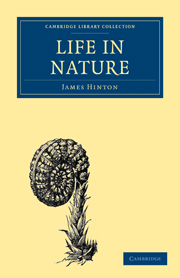Book contents
- Frontmatter
- Contents
- INTRODUCTION
- CHAPTER I OF FUNCTION; OR, HOW WE ACT
- CHAPTER II OF NUTRITION; OR, WHY WE GROW
- CHAPTER III OF NUTRITION; THE VITAL FORCE
- CHAPTER IV OF LIVING FORMS; OR, MORPHOLOGY
- CHAPTER V OF LIVING FORMS; THE LAW OF FORM
- CHAPTER VI IS LIFE: UNIVERSAL?
- CHAPTER VII THE LIVING WORLD
- CHAPTER VIII NATURE AND MAN
- CHAPTER IX THE PHENOMENAL AND THE TRUE
- CHAPTER X FORCE
- CHAPTER XI THE ORGANIC AND THE INORGANIC
- CHAPTER XII THE LIFE OF MAN
- CHAPTER XIII CONCLUSION
- APPENDIX: AN ATTEMPT TOWARDS A MORE EXTENDED INDUCTION OF THE LAWS OF LIFE
CHAPTER XII - THE LIFE OF MAN
Published online by Cambridge University Press: 29 August 2010
- Frontmatter
- Contents
- INTRODUCTION
- CHAPTER I OF FUNCTION; OR, HOW WE ACT
- CHAPTER II OF NUTRITION; OR, WHY WE GROW
- CHAPTER III OF NUTRITION; THE VITAL FORCE
- CHAPTER IV OF LIVING FORMS; OR, MORPHOLOGY
- CHAPTER V OF LIVING FORMS; THE LAW OF FORM
- CHAPTER VI IS LIFE: UNIVERSAL?
- CHAPTER VII THE LIVING WORLD
- CHAPTER VIII NATURE AND MAN
- CHAPTER IX THE PHENOMENAL AND THE TRUE
- CHAPTER X FORCE
- CHAPTER XI THE ORGANIC AND THE INORGANIC
- CHAPTER XII THE LIFE OF MAN
- CHAPTER XIII CONCLUSION
- APPENDIX: AN ATTEMPT TOWARDS A MORE EXTENDED INDUCTION OF THE LAWS OF LIFE
Summary
But though organic life exhibits nature thus bounded and tied down, its characters are not the less rich in meaning. The laws which rule in it are the universal laws, and speak the universal language, exhibiting spiritual things to the eye of sense. What other than a spiritual fact is this, the most essential character of life: that it depends upon the resistance or control of one form of force by another? A passive force (properly called a (“passion”), kept in subjection, and only in regulated and determined modes suffered to come into play;—on this the seeming Life in Nature depends. Does it not speak to us of that control of passion which is Life indeed within us? Only by resistance, by restraint, is Life. The passion on which it rests, uncontrolled, leads to corruption, ends in death.
We cannot but be struck with this fact in the history of the seed: opening the eyes of our souls to read it. Operated upon by the forces which bring its latent “passion” into play—the chemical affinities which its elements contain—the seed begins to undergo a change, the decomposition of its substance. But mark the difference. This change arises alike in the fertile and the infertile seed; it is the starting point at once of life and death.
- Type
- Chapter
- Information
- Life in Nature , pp. 205 - 220Publisher: Cambridge University PressPrint publication year: 2009First published in: 1862

